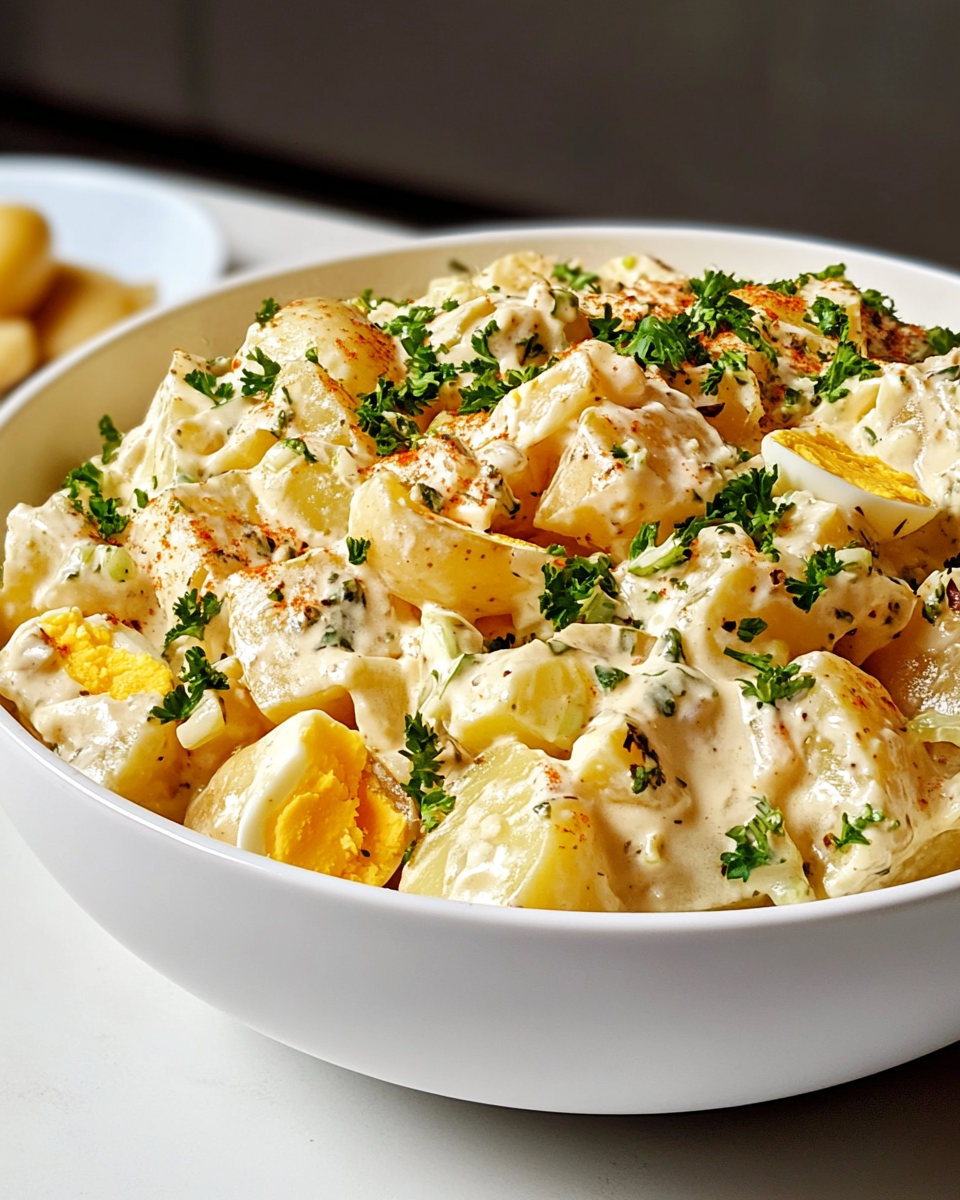A timeless favorite, this classic potato salad is creamy, tangy, and perfectly seasoned. It’s the ultimate side dish for picnics, barbecues, or any gathering where you want a crowd-pleaser that’s easy to make and full of comforting flavor.
FULL RECIPE
Ingredients
- 3 pounds Yukon Gold or red potatoes, peeled and cut into chunks
- 3 large hard-boiled eggs, chopped
- 1 cup mayonnaise
- 2 tablespoons yellow mustard
- 1/2 cup finely chopped celery
- 1/4 cup finely chopped red onion
- 2 tablespoons sweet pickle relish
- 1 tablespoon apple cider vinegar
- 1 teaspoon sugar
- Salt and freshly ground black pepper, to taste
- 2 tablespoons chopped fresh parsley (optional)
- Paprika for garnish (optional)
Directions
- Place the potatoes in a large pot and cover with cold water. Add a pinch of salt. Bring to a boil, then reduce heat and simmer until potatoes are tender but still firm, about 10-15 minutes. Drain and let cool slightly.
- In a large bowl, combine mayonnaise, mustard, vinegar, sugar, salt, and pepper. Mix well to create the dressing.
- Add the warm potatoes to the dressing and gently fold until the potatoes are coated.
- Fold in the chopped eggs, celery, onion, and pickle relish. Taste and adjust seasoning with more salt, pepper, or vinegar if needed.
- Cover and refrigerate for at least 2 hours to let flavors meld.
- Before serving, sprinkle with chopped parsley and a light dusting of paprika if desired.
Nutrition Facts
- Calories: 280
- Total Fat: 18g
- Saturated Fat: 3g
- Cholesterol: 70mg
- Sodium: 350mg
- Total Carbohydrates: 22g
- Dietary Fiber: 2g
- Sugars: 3g
- Protein: 5g
History of Classic Potato Salad
Classic potato salad has roots tracing back to 19th-century Europe, particularly Germany and Austria, where simple boiled potatoes dressed with vinegar and herbs were a staple. Immigrants brought these recipes to America, where variations evolved with the addition of mayonnaise and mustard, making it the creamy, tangy side dish beloved today. Its enduring popularity is tied to its adaptability and comfort-food appeal.
Varieties of Potato Salad
While the classic American version is creamy and mayonnaise-based, potato salad comes in many regional varieties worldwide. German potato salad is often served warm with a vinegar and bacon dressing, while Mediterranean versions might use olive oil, lemon, and fresh herbs. Understanding these variations helps appreciate the diversity of flavors and textures possible with this humble dish.
Best Potatoes for Potato Salad
Choosing the right potatoes is crucial. Waxy potatoes like Yukon Gold or red potatoes hold their shape well after cooking and provide a creamy texture without turning mushy. Starchy potatoes like Russets tend to break down more, which can create a gluey salad. Selecting the proper potato ensures the perfect consistency and mouthfeel.
The Role of Mayonnaise and Mustard
Mayonnaise is the creamy base that defines the classic potato salad’s richness, while mustard adds a subtle tang and depth of flavor. Yellow mustard is traditional, but Dijon or spicy brown mustard can add complexity. The balance between these two ingredients is key to achieving the ideal creamy yet bright dressing.
The Importance of Texture
Texture is just as important as flavor in potato salad. The salad should have tender but firm potato chunks mixed with crunchy celery and onion for contrast. The chopped hard-boiled eggs add a soft, creamy bite, while the relish introduces a slight crunch and sweetness, making each spoonful satisfying and well-rounded.
How to Make Potato Salad Ahead of Time
Potato salad benefits from resting time, ideally 2 to 24 hours in the refrigerator, to allow the flavors to meld. Preparing it ahead of time not only saves effort on the day of serving but also improves taste as the dressing fully penetrates the potatoes and other ingredients, making the salad more flavorful and cohesive.
Health Considerations
While delicious, traditional potato salad can be high in calories and fat due to the mayonnaise. For a lighter version, you can substitute part or all of the mayo with Greek yogurt or avocado. Adding more fresh vegetables like celery and onions boosts fiber and nutrients, making the dish a bit healthier without sacrificing taste.
Serving Suggestions
Classic potato salad is incredibly versatile. It pairs perfectly with grilled meats, fried chicken, and seafood, making it a picnic or barbecue staple. It also works well as a side for sandwiches or as a light lunch on its own. Garnishing with fresh herbs or paprika adds visual appeal and extra flavor.
Storage Tips
Store potato salad in an airtight container in the refrigerator and consume within 3 to 5 days for best freshness. Avoid leaving it out at room temperature for extended periods, especially during warm weather, as mayonnaise-based dishes can spoil quickly. Proper storage keeps it safe and delicious.
Common Mistakes to Avoid
Overcooking the potatoes is a common mistake that results in a mushy salad. Also, not seasoning the potatoes while cooking can leave the dish bland. Adding dressing while the potatoes are warm helps absorption but too much heat can break down the salad. Balancing flavors and textures is key to success.
Customizing Your Potato Salad
Potato salad is a great base for creativity. Adding ingredients like chopped pickles, fresh herbs, bacon bits, or even a dash of hot sauce can personalize the salad to your taste. Experimenting with different mustards or vinegars can also create new flavor profiles, keeping this classic dish fresh and exciting.
Potato Salad for Special Diets
Potato salad can be adapted for various dietary needs. For gluten-free, ensure all added ingredients are gluten-free. Vegan versions replace mayonnaise with plant-based alternatives and omit eggs. Low-fat versions use lighter dressings. This adaptability makes potato salad a dish that can fit into many lifestyles.
Potato Salad as a Meal
While traditionally served as a side dish, potato salad can be transformed into a satisfying main course with a few additions. Incorporating proteins like grilled chicken, tuna, bacon, or even chickpeas can turn it into a hearty and balanced meal. Adding more vegetables—such as peas, bell peppers, or cherry tomatoes—boosts its nutritional value and makes it more filling. Served chilled or at room temperature, it’s a convenient and flavorful option for lunch or a light dinner, especially during warmer months.
Conclusion
Classic potato salad is much more than a simple side dish; it’s a versatile, flavorful staple with rich history and endless possibilities. Its perfect balance of creamy dressing, tender potatoes, and crisp add-ins makes it a crowd-pleaser across all seasons. By understanding its background, ingredients, and preparation tips, you can elevate your potato salad and make it a standout feature at any meal or gathering.






